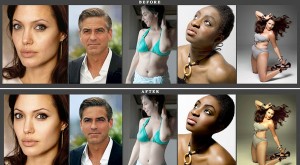Can you enhance my look just a tiny bit? Can you shed off my love handles, make my thighs look leaner, make my eyes pop, clear all those wrinkles, and perk up my boobs. These are the most common requests when we do a celebrity or model photo-shoot.
The photographs of celebrities and models in fashion advertisements and magazines are routinely buffed with a helping of digital polish. The retouching can be slight — colors brightened, a stray hair put in place, a pimple healed. Or it can be drastic — shedding 10 or 20 pounds, adding a few inches in height and erasing all wrinkles and blemishes, done using Adobe’s Photoshop software, the photo retoucher’s magic wand.
Well, soon you may be able to tell what was altered on these photographs, thanks to Hany Farid, a professor of computer science and a digital forensics expert at Dartmouth. Dr. Farid and Eric Kee, a Ph.D. student in computer science at Dartmouth, are proposing a software tool for measuring how much fashion and beauty photos have been altered, a 1-to-5 scale that distinguishes the infinitesimal from the fantastic. Sort of like Photoshop CSI.
Their work is intended as a technological step to address concerns about the prevalence of highly idealized and digitally edited images in advertising and fashion magazines. Such images, research suggests, contribute to eating disorders and anxiety about body types, especially among young women.
The Dartmouth research could be “hugely important” as a tool for objectively measuring the degree to which photos have been altered.
The tool isn’t trying to demonize Photoshop or prevent creative people from using it. But if a person’s image is drastically altered, there should be a reminder that what you’re seeing is about as true as what you saw in ‘Avatar,’ the science-fiction movie with computer-generated actors and visual effects.
If/when this software tool materializes, the following may be 5 great uses for the new Photoshop detection tool.
1. Online dating sites. The guy looks way too hot. Let’s see if he’s had a little help with the airbrushing wand.
2. Beauty ads. How well does that mascara or cellulite cream really work, and how much of it is retouched? Now we’ll know if the desired effect is unattainable. (On the other hand, the jig is up if you’ve gotten rid of red eye. And red pimple. And crows feet. And muffin top.)
3. Retail websites. Do those jeans make that model’s butt look great, or was that the job of a crafty photo editor?
4. Celebrity photos. We may never know which stars have had plastic surgery, but if we know how much their cover photos were airbrushed that’s a start. And then we can stop comparing ourselves to unrealistic images.
5. Facebook. You just KNEW that one girl you went to high school with had been enhancing her album full of glamour shots. Now you finally have proof.
Source: New Yoirk Times.
